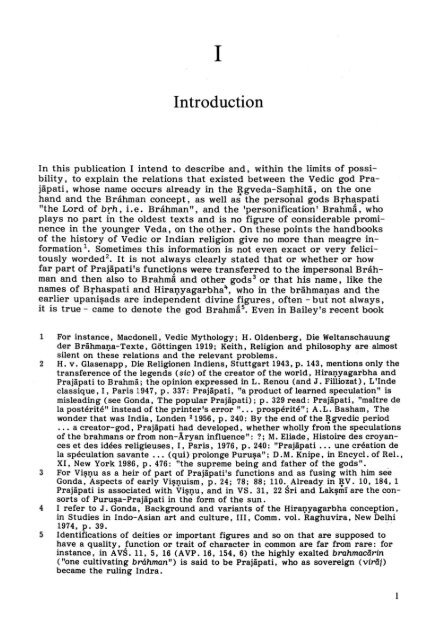Prajapati's relations with Brahman, Brhaspati and Brahma - DWC
Prajapati's relations with Brahman, Brhaspati and Brahma - DWC
Prajapati's relations with Brahman, Brhaspati and Brahma - DWC
Create successful ePaper yourself
Turn your PDF publications into a flip-book with our unique Google optimized e-Paper software.
I<br />
Introduction<br />
In this publication lintend to describe <strong>and</strong>, <strong>with</strong>in the limits of possibility,<br />
to explain the <strong>relations</strong> that existed between the Vedic god Prajäpati,<br />
whose name occurs already in the ~gveda-Sarphitä, on the one<br />
h<strong>and</strong> <strong>and</strong> the Bráhman concept, as wen as the personal gods Brh~spati<br />
"the Lord of brh, i. e. Bráhman", <strong>and</strong> the 'personification' Brahmä, who<br />
plays no part in the oldest texts <strong>and</strong> is no figure of considerable prominence<br />
in the younger Veda, on the other. On these points the h<strong>and</strong>books<br />
of the history of Vedic or Indian religion give no more than meagre information<br />
1. Sometimes this information is not even exact or very felicitously<br />
worded 2 • It is not always clearly stated that or whether or how<br />
far part of Prajäpati's functi9ns were transferred to the impersonal Bráhman<br />
<strong>and</strong> then also to Brahmä <strong>and</strong> other gods 3 or that his name, like the<br />
names of <strong>Brhaspati</strong> <strong>and</strong> HiraI].yagarbha\ who in the brähmaI].as <strong>and</strong> the<br />
earlier upanil?ads are independent divine figures, of ten - but not always,<br />
it is true - came to denote the god BrahmiP. Even in Bailey's recent book<br />
1 For instance, Macdonell, Vedic Mythology; H. Oldenberg, Die Weltanschauung<br />
der Brähma1',la-Texte, Göttingen 1919; Keith, Religion <strong>and</strong> philosophy are al most<br />
silent on these <strong>relations</strong> <strong>and</strong> the relevant problems.<br />
2 H. v. Glasenapp, Die Religionen Indiens, Stuttgart 1943, p. 143, mentions only the<br />
transference of the legends (sic) of the creator of the world, Hira1',lyagarbha <strong>and</strong><br />
Prajäpati to Brahmä; the opinion expressed in L. Renou (<strong>and</strong> J. Filliozat), L'lnde<br />
classique , I, Paris 1947, p. 337 : Prajäpati, "a product of learned speculation" is<br />
misleading (see Gonda, The popular Prajäpati); p. 329 read: Prajäpati, "maître de<br />
la postérité" instead of the printer's error" ... prospérité"; A.L. Basham , The<br />
wonde.r that was India, Londen 21956, p. 240: By the end of the ~gvedic period<br />
... a creator-god, Prajäpati had developed, whether wholly from the speculations<br />
of the brahmans or from non-Aryan influence": ?; M. Eliade, Histoire des croyances<br />
et des idées religieuses, I, Paris, 1976, p. 240: "Prajäpati ... une création de<br />
la spéculation savante ... (qui) prolonge Puru~a"; D.M. Knipe, in Encycl. of ReL,<br />
XI, New York 1986, p. 476: "the supreme being <strong>and</strong> fat her of the gods". _<br />
3 For Vi~1',lu as a heir of part of Prajäpati's functions <strong>and</strong> as fusing <strong>with</strong> him see<br />
Gonda, Aspects of early Vi~1',luism, p. 24; 78; 88; UO. Already in ~V. 10, 184,1<br />
Prajäpati is associated <strong>with</strong> Vi~1',lu, <strong>and</strong> in VS. 31, 22 Sri <strong>and</strong> Lak~mï are the consorts<br />
of Puru~a-Prajäpati in the form of the sun.<br />
4 I refer to J. Gonda, Background <strong>and</strong> variants of the Hira1',lyagarbha concept ion ,<br />
in Studies in Indo-Asian art <strong>and</strong> culture, 111, Comm. vol. Raghuvira, New Delhi<br />
1974, p. 39. . .<br />
5 Identifications of deities or important figures <strong>and</strong> so on that are supposed to<br />
have a quality, function or trait of character in common are far from rare: for<br />
instance, in A VS. 11, 5, 16 (AVP. 16, 154, 6) the highly exalted brahmacärin<br />
("one cultivating bráhman") is said to be Prajäpati, who as sovereign (viräj)<br />
became the ruling Indra.
















